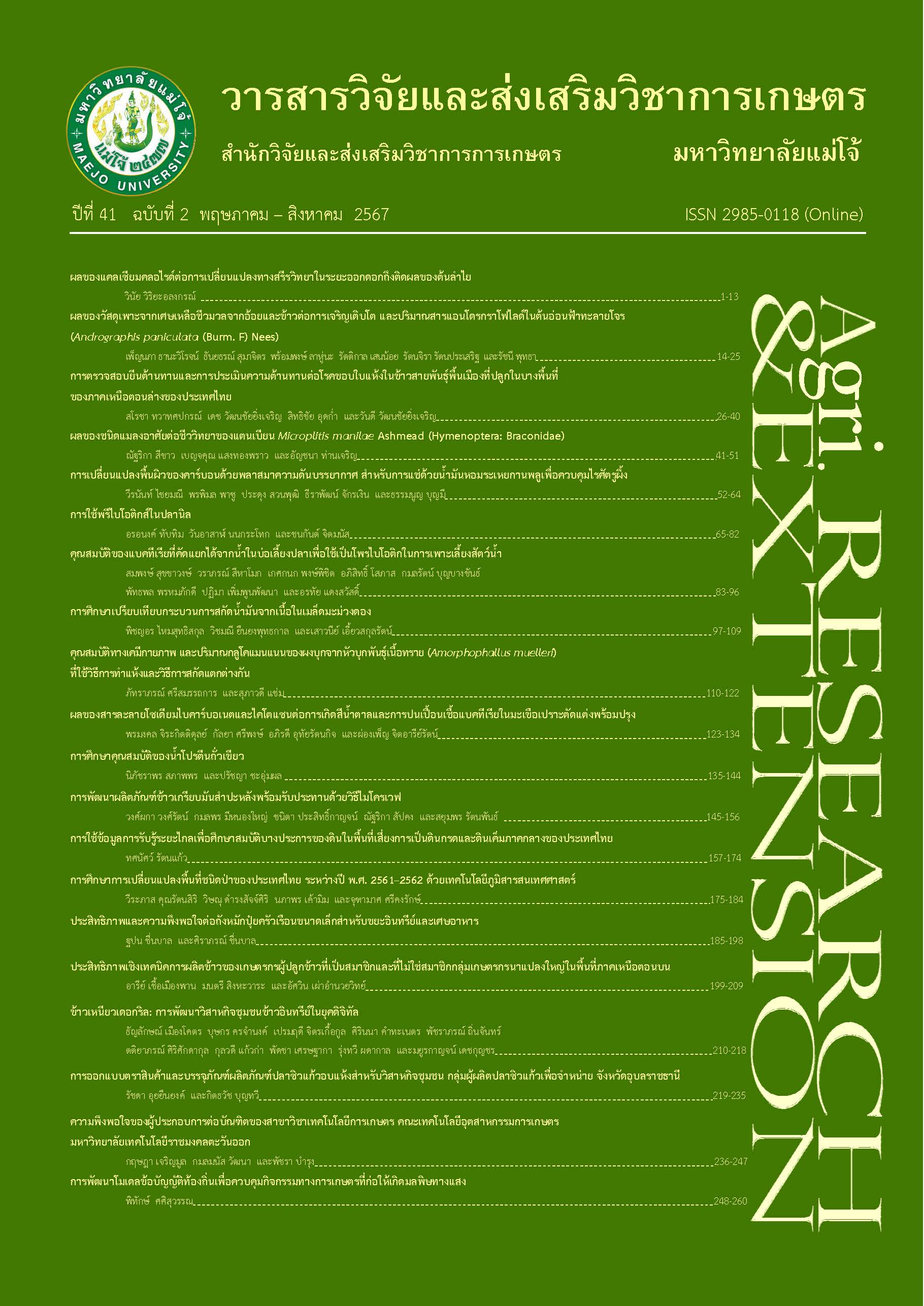คุณสมบัติทางเคมีกายภาพ และปริมาณกลูโคแมนแนนของผงบุกจากหัวบุกพันธุ์เนื้อทราย (Amorphophallus muelleri) ที่ใช้วิธีการทำแห้งและวิธีการสกัดแตกต่างกัน
DOI:
https://doi.org/10.14456/jare-mju.2024.29คำสำคัญ:
บุกผง, Amorphophallus muelleri , ผงบุก , กลูโคแมนแนนบทคัดย่อ
หัวบุกพันธุ์เนื้อทรายประกอบด้วยกลูโคแมนแนน ซึ่งเป็นสารไฮโดรคอลลอยด์ที่ทำให้เกิดความข้นหนืดและทำให้เกิดเจลได้ กลูโคแมนแนนเป็นเส้นใยอาหารที่ไม่ให้พลังงาน จึงใช้เป็นสารเพิ่มความข้นหนืดและใช้ในอุตสาหกรรมอาหาร งานวิจัยนี้มีวัตถุประสงค์เพื่อศึกษาคุณสมบัติทางกายภาพ-เคมี และปริมาณสารกลูโคแมนแนนสูงของผงบุกที่ได้จากบุกแห้งที่ใช้วิธีการทำแห้ง ได้แก่ ใช้ตู้อบลมร้อนที่ 60+2oซ. และตู้อบแสงอาทิตย์ และวิธีการสกัดผงบุก ได้แก่ การขัดอนุภาคเชิงกล; KPM และการสกัดด้วยสารละลายเอทานอล; KPE ที่แตกต่างกัน ผลการศึกษาพบว่า ผงบุกที่สกัดด้วยเอทานอลจากบุก อบแห้งด้วยตู้อบลมร้อน; KPETD มีปริมาณกลูโคแมนแนน สูงที่สุด โดยมีปริมาณร้อยละ 87.46±0.77 ซึ่งไม่แตกต่างจากผงบุกการค้าที่มีอยู่ร้อยละ 85 ผงบุกมีปริมาณความชื้น ค่า pH ค่าสีแดง (a*) และสีเหลือง (b*) ระดับสูงและมีค่าความสว่างสี (L*) ระดับปานกลาง อีกทั้งมีค่าความหนืดที่จุดสูงสุดและความหนืดสุดท้ายสูงกว่าตัวอย่างอื่น ๆ ผงบุกที่สกัดโดยการขัดอนุภาคเชิงกลจากบุกอบแห้งด้วยตู้อบลมร้อน; KPMTD มีค่า L* และปริมาณออกซาเลทสูงสุด แต่มีค่า a* และ b* ต่ำสุด ผงบุกที่สกัดโดยวิธีขัดอนุภาคเชิงกลจากบุกอบแห้งด้วยตู้อบแสงอาทิตย์; KPMSD มีปริมาณกลูโคแมนแนนและความหนืดสุดท้ายต่ำสุด ส่วนผงบุกสกัดด้วยเอทานอลจากบุกอบแห้งด้วยตู้อบแสงอาทิตย์; KPESD มีค่าสี b* และความหนืดสูงสุดระดับสูง แต่มีปริมาณความชื้นและออกซาเลทต่ำสุด โดยผลการวิจัยพบว่าผงบุกทุกตัวอย่างที่ศึกษามีค่าความหนืดสูงสุดมากกว่าผงบุกการค้าที่นำมาเปรียบเทียบ
เอกสารอ้างอิง
Aanisah, N., Y.W. Wardhana, A.Y. Chaerunisaa and A. Budiman. 2022. Review on modification of glucomannan as an excipient in solid dosage forms. Polymer (Basel) 14(13): 1-15. DOI: 10.3390/polym14132550
AOAC. 2005. Official methods of analysis of AOAC International. 18th. Gaithersburg, MD: AOAC International. 268 p.
Borompichaichartkul, C., R. Impaprasert, O. Mekkerdchoo, R. Jiamjariyatam and P. Tripetch. 2016. A Guide to the Use of Konjac "Usage Guidelines and Recommendations for Standardized and Safety Production". Bangkok: Agricultural Research Development Agency (Public Organization) Press. 35 p. [in Thai]
Botanical and Herbarium Research. 2020. Utilization of Biological Bases of Konjac Genus in Thong Pha Phum Area. Bangkok: Plant Varity Protection Division, Department of Agriculture. [Online]. Available https://www.doa.go.th/pvp/wpcontent/uploads/2020/09/Amorphophallus-spp.pdf (June 30, 2023). [in Thai]
Cham, S. and P. Srisamatthakarn. 2018. Development of extraction method of konjac powder from Amorphophallus konjac (Amorphophallus oncophyllus) by mechanical particles technique. Agricultural Science Journal 49(1) Suppl.: 605-608. [in Thai]
Chao, W., X. Zhong, M. Chen, D. Li and W. Lv. 2011. Structure and properties of konjac glucomannan solved in alcohol/water. Advanced Materials Research 197: 1310-1314.
Chen, H.L., H.C. Cheng, W.T. Wu, Y.J. Liu and S.Y. Liu. 2008. Supplementation of konjac glucomannan into a low-fiber Chinese diet promoted bowel movement and improved colonic ecology in constipated adults: a placebo-controlled, diet-controlled trial. Journal of the American College of Nutrition 27: 102-108.
Chen, H.L., Y.H. Fan, M.E. Chen and Y. Chan. 2005. Unhydrolyzed and hydrolyzed konjac glucomannans modulated cecal and fecal microflora in Balb/c mice. Nutrition 21: 1059-1064.
Chiu, Y.T. and M. Stewart. 2012. Comparison of konjac glucomannan digestibility and fermentability with other dietary fibers In Vitro. Journal of Medicinal Food 15(2): 120-125.
Chua, M., K. Chan, T.J. Hocking, P.A. Williams, C.J. Perry and T.C. Baldwin. 2012. Methodologies for the extraction and analysis of konjacglucomannan from corms of Amorphophallus konjac K. Koch. Carbohydrate Polymers 87(3): 2202-2210.
Cochran, W.G. and G.M. Cox. 1992. Experimental Design. 2nd. New York: John Wiley and Sons. 640 p.
Faridah, A. and S.B. Widjanarko. 2013. Optimization of multilevel ethanol leaching process of porang flour (Amorphophallus muelleri) using response surface methodology. International Journal on Advanced Science Engineering and Information Technology 3(2): 74-80.
Food Division, Food and Drug Administration. 2012. Codex Advisory Specification for the Identity and Purity of Food Additives Vol. 1. [Online]. Available https://food.fda.moph.go.th/data/FoodAdditives/food_additives_V1.pdf (June 30, 2023). [in Thai]
Harmayani, E., V. Aprilia and Y. Marsono. 2014. Characterization of glucomannan from Amorphophallus oncophyllus and its prebiotic activity In Vivo. Carbohydrate Polymers 112: 475-479.
Impaprasert, R. 2013. Production of Purified Konjac Flour from Corms of Buk Nuea Sai Amorphophallus muelleri. Doctoral Dissertation. Chulalongkorn University. 222 p.
Nurlela, N., N. Ariesta, E. Santosa and T. Muhandri. 2022. Physicochemical properties of glucomannan isolated from fresh tubers of Amorphophallus muelleri Blume by a multilevel extraction method. Food Research 6(4): 345-353.
Parry, J. 2010. Konjac Glucomannan. pp. 198-217. In Imeson, A. (ed.). Food Stabilisers, Thickeners, and Gelling Agents. Singapore: John Wiley and Sons Ltd., Hoboken.
Peiying, L., Z. Shenglin, Z. Guohua, C. Yan, O. Huaxue, H. Mei, W. Zhongfeng, X. Wei and P. Hongyi. 2002. Professional Standard of the Konjac Flour. Beijing: Professional Standard of the People’s Republic of China for Agriculture Konjac: Flour (NY/T 494-2002), Ministry of the People's Republic of China. 8 p.
Phukasmart, U. 2013. Konjac herbal plant for health. Food 43(4): 55-57. [in Thai]
Rouarut, K. 2021. "Konjac" but not invade the forest. [Online]. Available https://www.hrdi.or.th/Articles/Detail/141 (April 20, 2022). [in Thai]
Srisamatthakarn, P., S. Cham, R.P. Na Ayuthaya, P. Manochai and P. Na Nan. 2019. Project to Develop Healthy Food Product Prototypes from Konjac (Amorphophallus spp.) for Application in Food Industry. 72 p. In Research Report. Lampang: Agricultural Technology Research Institute, Rajamangala University of Technology Lanna. [in Thai]
Srisamatthakarn, P., S. Cham, J. Pongjanta, N. Chomsri, R.P. Na Ayuthaya and P. Manochai. 2021. Value Added Creation and Raising the Agricultural Product Standard Quality towards Sustainable Innovation Community Development. 402 p. In Research Report. Lampang: Agricultural Technology Research Institute, Rajamangala University of Technology Lanna. [in Thai]
Sukumolnondha, T. 2009. Varieties of Konjac in Thailand. Chiangmai: Office of Agricultural Research and Development Region 1, Department of Agriculture. 59 p. [in Thai]
Tester R. and F.H. Al-Ghazzewi. 2017. Role of glucomannans in immunology. Journal of Pharmacy & Pharmaceutical Sciences 20(0): 97-114.
Tye, R.J. 1991. Konjac flour: properties and applications. Food Technology 45(3): 82-92.
Xu, X.Q. and Z.Q. Zhang. 2000. Kinetic spectrophotometric determination of oxalic acid based on the catalytic oxidation of bromophenol blue. Microchimica Acta 135: 169-172.
Xu, W., Y. Wang, W. Jin, S. Wang, B. Zhou, J. Li, B. Li and L. Wang. 2014. A one-step procedure for elevating the quality of konjac flour: Azeotropy-assisted acidic ethanol. Food Hydrocolloids 35: 653-660.
Ye, W., B. Yan, J. Pang, D. Fan, J. Huang, W. Zhou, X. Cheng, H. Chen and H. Zhang. 2019. A Study of the synergistic interaction of konjac glucomannan/curdlan blend systems under alkaline conditions. Materials 12(21): 1-5. DOI: 10.3390/ma12213543
Zhao, J., D. Zhang, G. Srzednicki, S. Kanlayanarat and C. Borompichaichartkul. 2010. Development of a low-cost two-stage technique for production. International Food Research Journal 17: 1113-1124.
ดาวน์โหลด
เผยแพร่แล้ว
รูปแบบการอ้างอิง
ฉบับ
ประเภทบทความ
สัญญาอนุญาต
ลิขสิทธิ์ (c) 2024 วารสารวิจัยและส่งเสริมวิชาการเกษตร

อนุญาตภายใต้เงื่อนไข Creative Commons Attribution-NonCommercial-NoDerivatives 4.0 International License.
บทความนี้ได้รับการเผยแพร่ภายใต้สัญญาอนุญาต Creative Commons Attribution-NonCommercial-NoDerivatives 4.0 International (CC BY-NC-ND 4.0) ซึ่งอนุญาตให้ผู้อื่นสามารถแชร์บทความได้โดยให้เครดิตผู้เขียนและห้ามนำไปใช้เพื่อการค้าหรือดัดแปลง หากต้องการใช้งานซ้ำในลักษณะอื่น ๆ หรือการเผยแพร่ซ้ำ จำเป็นต้องได้รับอนุญาตจากวารสาร





